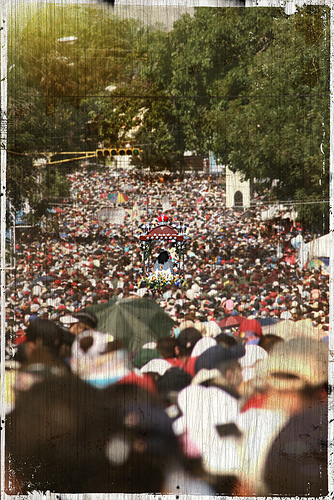
Flickr user, Ram Martinez recently uploaded this photo, “The Procession (Sea of People)” and explained the event in an informative description which I will have translated here.
La Divina Pastora (The Divine Shepherdess) is one of Venezuela's most important religious icons. She is the patron saint of the city of Barquisimeto and is one of the most followed virgin saints in this region of the country. Every 14th of January is celebrated with a crowded procession in which this image is carried from Santa Rosa to the capital of the state, Lara. Later, it returns to its native town, passing by the temples and churches of each parish along the way.
According to the history books, this deity comes from Sevilla, Spain. A Capuchino priest by the name of Isidoro received a revelation in one of his dreams. It was the image of the divine Shepherdess. A few days later, he gave the artist, Miguel Alonso de Tovar a detailed description in order to create a painting. The image of the virgin in a shepherd's hat, covered in a blue cloak, holding a baby in her left hand and a lamb in her right, was called, “Divine Shepherdess of Souls.”
Years later, the sculptor Francisco Antonio Gijón carved a to-scale sculpture of the Divine Shepherdess and in 1705, it was carried in its first procession in this European country.
The history of the Divine Shepherdess in Venezuela goes back to 1736 when the parish priest of Santa Rosa commissioned a sculptor do do a piece of the Immaculate Conception. Without any explanation, the figure that arrived was the one of the Divine Shepherdess and although the priest wanted to return it, they were not able to carry it back to the shipping container. The whole town deduced from the strange fact that the religious efigie should remain in Santa Rosa.
In addition to this curious story, in the 19th century another fantastic event took place which ensured that this deity would become the patron saint of Lara. In 1855, there was a large cholera outbreak that hit Venezuela. Many of Barquisimeto's families suffered greatly and in desperation, sought help from the religious image. One legend says that parish priest, Jose Macario Yépez offered himself before the Virgin as the last victim of the epidemic. Some historians say that six months after the offer, the priest died and the outbreak stopped.
In commemoration of this miracle, every 14th of January a procession takes place to honor the Divine Shepherdess. It begins in the town of Santa Rosa and continues until the Metropolitan Cathedral of Barquisimeto. And from January 14th until Palm Sunday, the image of the Divine Shepherdess passes by Lara's 44 temples.
Every year, thousands of people meet to participate together in one of Venezuela's largest processions, which crosses approximately five kilometers. During the rest of the year, the icon can be found in the church of Santa Rosa, a village near the Lara's state capital. It is there that all of the region's indigenous come to venerate the Divine Shepherdess in devotion, faith, and hope. They offer the icon hats, suits, and precious fabrics. In the Caracas neighborhood, “La Pastora” a temple was constructed in 1745 dedicated to this Virgin.







1 comment
“Ikons” are raised statues usually carried on the shoulders of religious parade participants. In more normal circumstances a process also refers to a judicial trial; therefore, being processed entails being tried.
Processions are yearly events in many cities of Spain. These mostly outdoor worshipping activities is typical of such charismatic and deeply faithful society, as it involves “cofradías” or brotherhoods that are in charge of all details related to motions, vestments, safekeeping, maintenance, etc., obviously sanctioned by the Catholic church.
As mentioned in article, this custom later spread to many Latin American countries where it is closely followed, revered, and guarded.
Regarding the possible origins of these events one would have to associate them with the stations of the cross, or the walk of Christ prior to his crucifixion. In many large church buildings these on-site public reenactments are the preamble for the outer activities seen here.
In terms of the so-called pagan boys runs through the countryside to delight home dwellers, gather some food and drink, perform some chanting, etc., we would have to deduce that primitive inhabitants were very much addicted to feasts and festivals, and their celebrations were the result of previously occurring events in a similar cyclic fashion as we see today.
So, some of these rituals are mere readaptations of extremely ancient customs and traditions…
Filename: NVProcession2006